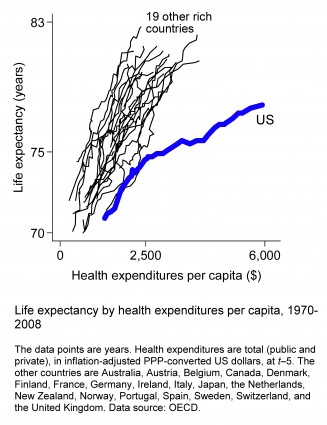The US has the lowest life expectancy of any of the 20 richest nations and vastly higher per-capita healthcare costs. Okay, I think we knew that, but we didn't know until Lane Kenworthy did the analysis and posted the following chart on his blog that something(s) happened in the early 1980s that resulted in our going from just being one of the worst performers in this group to being a radical high-cost, short-lives outlier.
 (Dollar figures are indexed to 2005. Life expectancies are at birth.)
(Dollar figures are indexed to 2005. Life expectancies are at birth.)
Looking at the black lines representing the other 19 nations, they all have about the same slope of increasing life expectancy vs. increasing expenditures. Until the early 1980s, the US trend line was on that same slope, but then we alone veered off into a zone of radically increasing costs without achieving any improvement in our near-the-bottom life expectancy ranking in this group of 20. Of course, this graph does not tell us what caused the divergence, but it does point to a time period that should get our attention. What US policy changes, or market changes that affected only the US, were occurring then and continuing?
My top targets for investigation would be out-patient care and administration. Kenworthy's post links to some good sources, especially this September 30, 2009 OECD report to Congress. Chart 8 there compares healthcare spending by category (out-patient, in-patient, drugs, etc.) among the US, Canada, France, Germany, and Japan.

 Note that in all seven categories, the US spends more than any of the others, but what stands out the most is that the US spends 2.4 times as much as the second-place nation on out-patient care and 2.1 times as much on administration. If both of these categories had been only at the levels of the second-place nations, US healthcare spending would have been $2,132 per-capita (29%) less than it actually was in 2007. In-patient care costs alone would have been $1,863 lower. Together these two categories were 53% of 2007 US healthcare spending.
Note that in all seven categories, the US spends more than any of the others, but what stands out the most is that the US spends 2.4 times as much as the second-place nation on out-patient care and 2.1 times as much on administration. If both of these categories had been only at the levels of the second-place nations, US healthcare spending would have been $2,132 per-capita (29%) less than it actually was in 2007. In-patient care costs alone would have been $1,863 lower. Together these two categories were 53% of 2007 US healthcare spending.
One possible explanation for the divergence in the first chart above is that when wages and salaries for middle-income Americans started being limited to the inflation rate in about 1973, incomes of US healthcare providers kept rising faster than inflation. If that happened, it might well be because the US healthcare sector has been very effective, politically and/or otherwise, in protecting its incomes from the general stagnation of real personal incomes. If that's what happened, and if the incomes of the healthcare sector in the other 19 nations only kept pace with inflation, we should expect the above graph to look like it does.
 Skeptic
Skeptic






